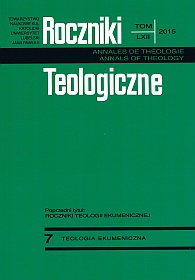Biblical Motif of Tearing of a Vesture as a Symbol of Division of a Community in the Light of 1 Kings 11:29–39 and John 19:23–24
Abstract
The presented article analyzes two texts, in which a motif of tearing of the garment which is used symbolically, occurs. In 1 Kings 11:29–39 the divided cloak of Jeroboam becomes a symbol for divided Davidic kingdom. It will be divided into two kingdoms: Israel and Judah. According to theological interpretation the reason for this division is the sin of king. The Text of John 19:23–24 describes the scene of the division of Jesus’s garment. The untorn tunic of Jesus symbolizes the unity of the Church. In the case of the scene presented in the Fourth Gospel, we have a double meaning of it. At first it indicates a variety, which exists in the Church, that reaches to the ends of the earth. Then it stresses the fact that the community of the Church, indeed variegated, is the one, undivided community. It is possible, because it origins „from above”, it is not made by any human hand.
References
Brown, Raymond E. The Death of Messiah. From Gethsemane to the Grave. Vol. 2. (The Anchor Bible Reference Library). New York–London–Toronto: Doubleday 1998.
Cogan, Mordechai. 1 Kings. A New Translation with Introduction and Commentary. (Anchor Bible 10). New York: Yale University Press, 2001.
Cohn, Robert L. “Literary Technique in the Jeroboam Narrative.” Zeitschrift für die alttestamentliche Wissenschaft 98 (1985), No. 1: 23–35.
Culpepper, Alan. “The Theology of the Johannine passion narrative: John 19:16b-30.” Neotestamentica 31 (1997), No. 1: 21–37.
de la Potterie, Ignace: Męka Jezusa Chrystusa. Kraków: WAM, 2006.
DeVries Simon J. 1 Kings. (WBC 12). Nashville: Thomas Nelson Publishers, 2003.
Ewald, Heinrich. The History of Israel. Vol. 3: The Rise and Splendor of the Hebrew Monarchy. London: Longman, Greens and Co., 21878.
Leuchter, Mark. “Jeroboam the Ephratite.” Journal of Biblical Literature 125 (2006): 51–72.
Linville, James Richard. Israel in the Book of Kings. (Journal for the Study of the Old Testament Supplement Series 272). Sheffield: Sheffield Academic Press, 1998.
Min Chun, S. “Whose Cloak did Ahijah Seize and Tear? A Note on 1 Kgs 11,29-30.” Vetus Testamentum 56 (2006), 268–74.
Schnackenburg, Rudolf. Das Johannesevangelium 13-21. (Herders Theologischer Kommentar zum Neuen Testament IV/3; Sonderausgabe). Freiburg–Basel–Wien: Herder, 2001.
St. Augustine. Tractates on the Gospel of John 112-124. (The Fathers of the Church. A New Translation 78). Translated and edited by J.W. Rettig. Washington: Catholic University of America Press, 1995.
St. Cyprian. Treatises. (The Fathers of the Church. A New Translation 36). Translated and edited by R.J. Deferrari. New York: Catholic University of America Press, 1958.
Siemieniec, Tomasz. “Division (schisma) as a Reaction to Self-Manifestation of Jesus’ Person in the Light of John 7,43.” Studia Oecumenica 13 (2013): 139–47.
Tułodziecki, Tomasz. Jeroboam – reformator religii Izraela. (Rozprawy i Studia Biblijne 14). Warszawa: Vocatio, 2004.
Weippert, Helga. “Die Ätiologie des Nordreiches und seines Königshauses (I Reg 11,29-40).” Zeitschrift für die alttestamentliche Wissenschaft 95 (1983), No. 3: 344–75.
Copyright (c) 2015 Roczniki Teologiczne

This work is licensed under a Creative Commons Attribution-NonCommercial-NoDerivatives 4.0 International License.





